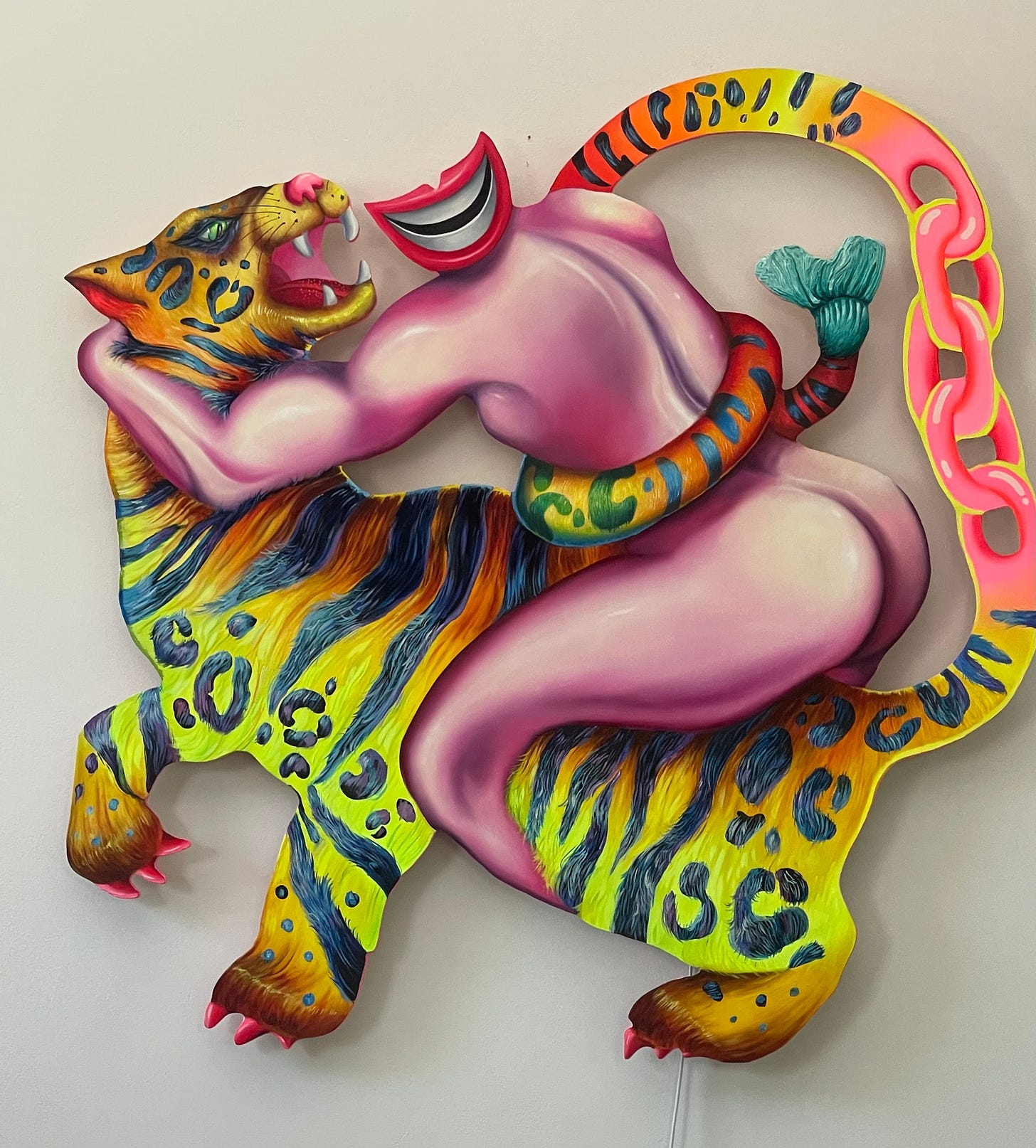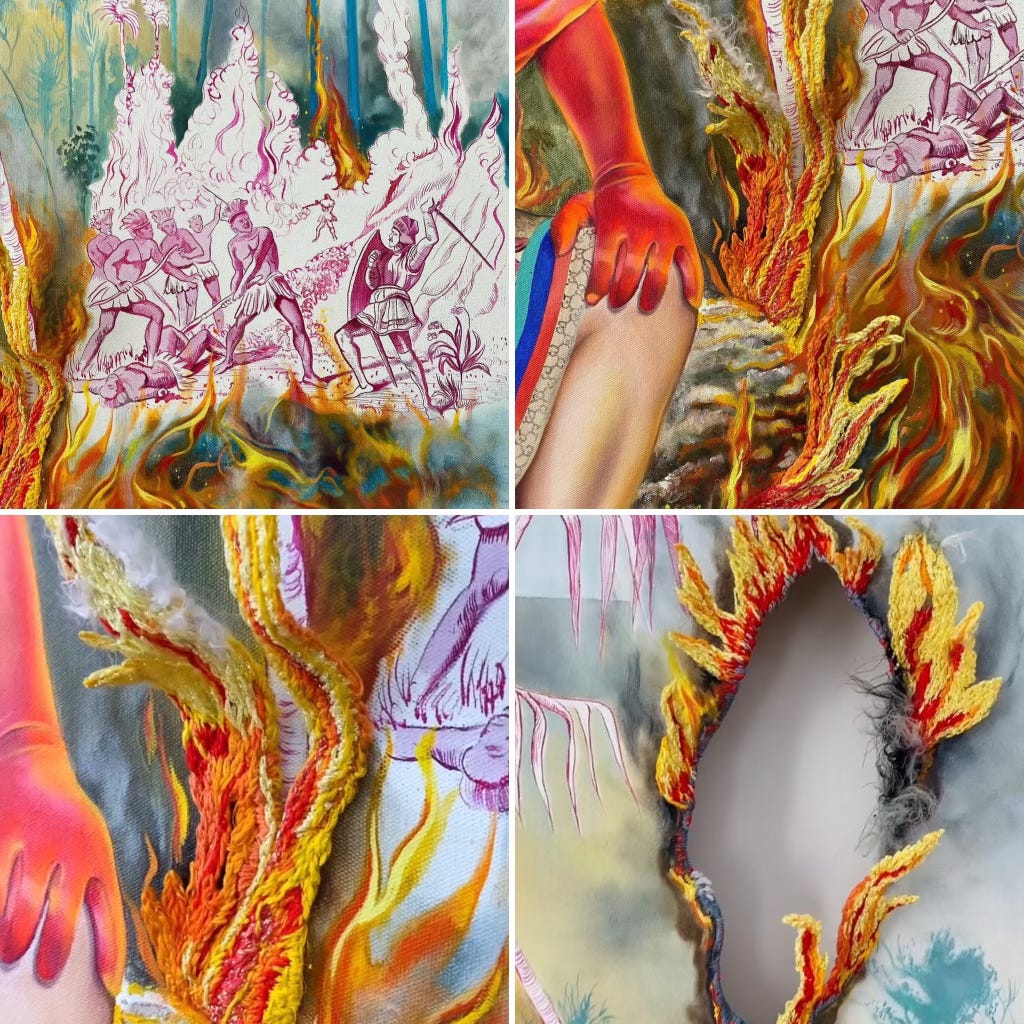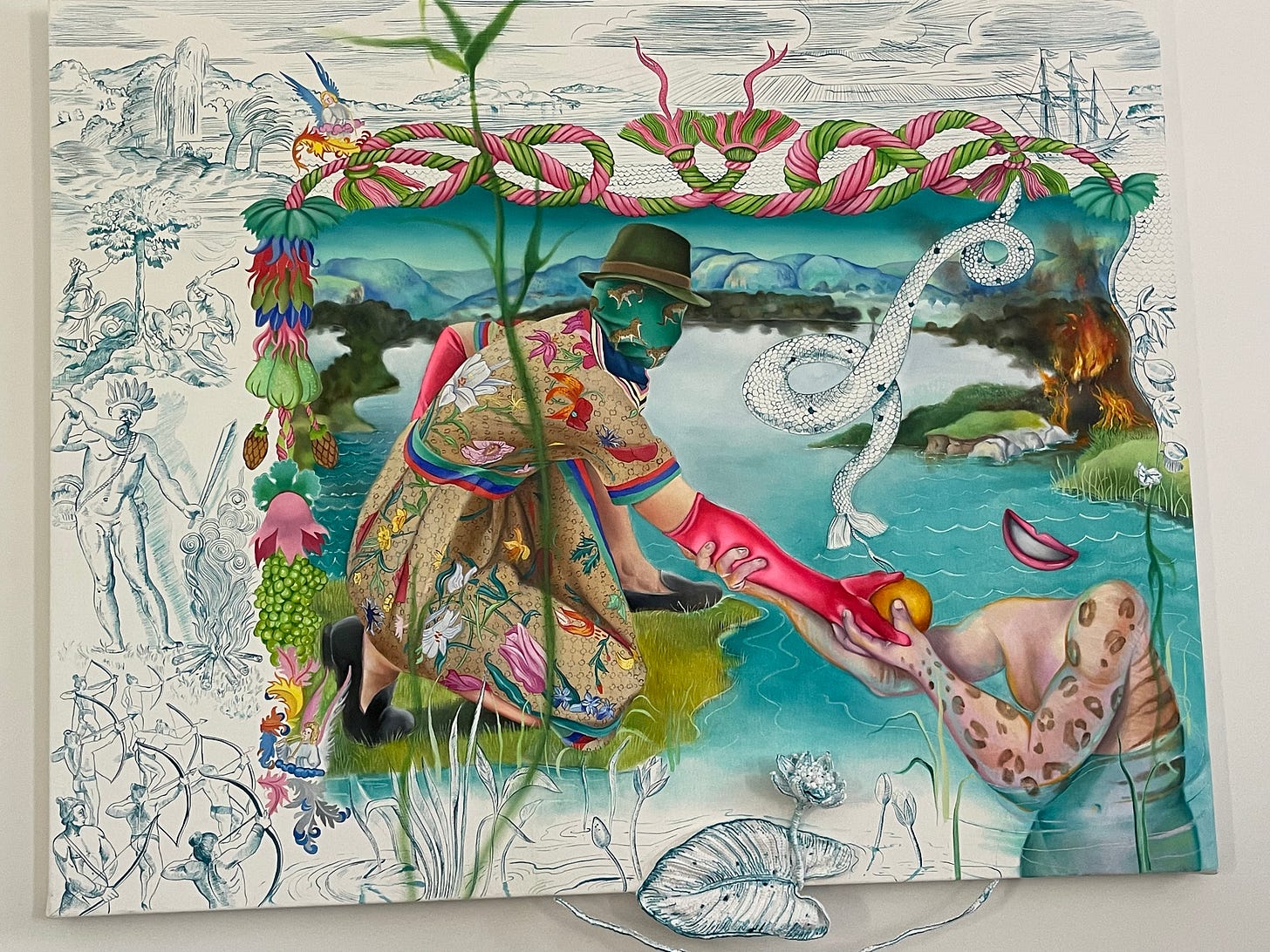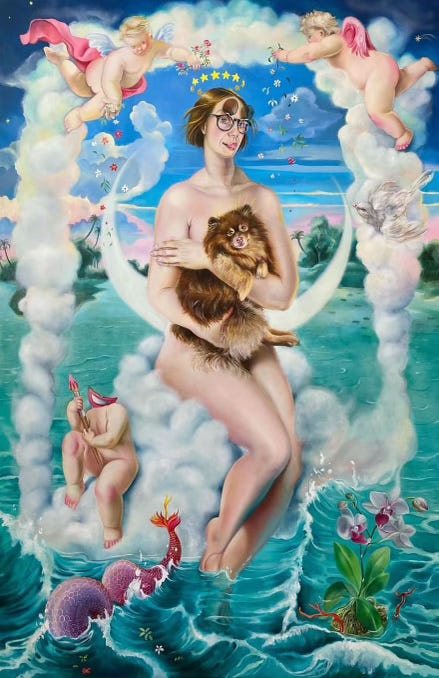Justyna and her impeccably stylish mascot Charlie Brown aka @thechocolatepomeranian
Born in Soviet-occupied Warsaw, Poland in 1983, artist Justyna Kisielewicz’s paintings brim with multi-layered, socio-political references, humor, and kaleidoscopic colors. Simmering beneath the hand-embroidered flames and luxury brand-clad figures in her paintings lies a biting critique of colonialism from someone who experienced the repressive and abusive Russian occupation first hand. As she says, “I was born into slavery,” a fact that makes her attuned to the trauma of colonialism. The photograph below is indicative of the drabness of Soviet brutalist architecture. This grey architecture and gloomy weather surrounded Justyna’s childhood, yet her art is the opposite of drab, just compare the picture of Soviet occupied Warsaw to her painting “The Frenzy.” For her art was an escape from the monochromatic, repressive Soviet occupation where she was given the choice of only 8 crayon colors (for reference the largest box currently contains 120). When she spoke about the influence of American cartoons and toys that were slowly allowed to enter Warsaw via cable TV I was reminded of my own childhood in Ecuador where coveted Fisher Price toys were scarce and imbued with a sense of magic.
An image of Warsaw, from the artist’s own archive.
The Frenzy (after Władysław Podkowiński)
When I first saw her work I assumed she was a Latinx painter. I was so viscerally drawn to her work, both the subject matter (she paints Andean “cholas” decked in luxury fashion) and her impeccable style. After learning that I was duped, and that she was European, I reached out and asked if I could meet her in person. She graciously hosted me at her Coral Gables, FL studio where I learned that aside from a recent trip to Mexico City, (and a very recent trip to Bogota), Justyna had never been to the Andes despite the monumental presence of Andean “cholitas” in many of her paintings.
El Pirata, oil and 3D embroidered flames on canvas, 2024
a detail of her fantastic embroidery - a skill she learned form her grandmother
“Cholas” are the indigenous women of Andes specifically Bolivia and Peru (ethnically they are Aymara and Quechua) who wear skirts to the knee, petticoats, style their hair in two long braids, and wear bowler hats (know in Bolivia as Borsalino after the eponymous brand). According to a report by the BBC these hats came in to the Andes in the 1920s from via British rail workers stationed there – but rural women made them their own. Traditionally the term ‘cholita’ was derogatory - it implied a person of lower socio-economic position and indigenous or mixed race (mestizo.) Yet today, all over the Andes, cholitas are a force, nascent symbols of national pride, stylish skate boarders, rappers etc.
This image is from Peruvian photographer Celia Luna’s stunning series “Cholitas Bravas"
During our visit I asked Justyna, just how these iconic and “traditional” Latin American outfits, transformed into a critique of luxury consumption, made it into her body of work? She said that growing up in Poland Latin America seemed impenetrable, yet somehow in her art she captures their magic like a native. Despite the differences between Soviet occupied Poland and the Andean highlands, they there is much in common, namely colonialism. The artist is more interested in what unites us than what separates or differentiates us, and that is a noble sentiment during these polarizing times.
“The Feast” or Heaven in Hell, Oil on canvas with 3D embroidered flames, 60 x 90 in, 2024
This painting epitomizes the magical realism I see in Justyna’s world, beginning with her self-portrait as a supplicant in the bottom left corner to the toile -like background filled with scenes denouncing colonialism. This work also includes another facet of her work: environmentalism. The painting addresses a specific Miami climate gentrification crisis. If you look at the house on the lower right side it is a Bahamian style house that was prevalent in Coconut Grove and is now being torn down to make room for pricey modern town homes that are unaffordable to any of the original tenants. This article explains how a 1,280-square-foot house like one in the painting in the “black Grove” aka Little Bahamas sold for $81,000, and today it’s estimated market value today is over $1 million dollars. In addition, the toile-like pink-hued background includes scenes from the colonization of the Americas including Spanish ships (upper left) and fantastical foliage (some of this fauna comes from Justyna’s frequent sketching sessions at Miami’s Fairchild Tropical Garden.)
Image from the blog ser chola esta de moda “to be a chola is in fashion”
Luxury Fashion, over consumption and scarcity
Dealing with Devil, oil and crochet on canvas
As aforementioned Justyna’s use of fashion and the ubiquitous branding of Gucci, Dior, Hermes etc is fitting given Miami’s emerging reign as a global luxury shopping destination. To me her work calls out the hypocrisy of this lucrative market, estimated at $284.00 billion in 2023, especially given the growing global wealth disparities. As someone who grew up in a society with food scarcity and few consumer choices, her brilliant inclusion of conspicuous branding is very cheeky!
It also makes her work so prescient, given the Dior handbag scandal a police raid and an Italian court discovered that Dior products were manufactured in sweatshop-like conditions by exploited “foreign labor.” And to add insult to injury it was made public that the Dior bags which retailed for $2,816 cost Dior a mere $57 to make, thats quite a mark-up and the joke is on the consumer of luxury goods. The aforementioned underpaid workers employed Chinese laborers who lived, ate and worked in sub standard and dangerous conditions from dawn to 9 PM including weekends and holidays. Dior, BTW, is owned by LVMH, whose founder Bernard Arnault has an estimated net worth of US$194 billion as of July 2024. I wrote about this at length in this linked essay called “Quiet Exploitation in the Andes: the slave labor of Loro Piana + LVMH.
-Wall Street Journal
In closing, the art of Justyna Kisielewicz deals with the dark shadows of political repression and scarcity and transforms her core memories into a glorious display of abundance, light and rich iconography. Her serene Coral Gables home studio, surrounded by the lush tropical landscape that can be seen in the her work, seems light light years away form the drab grey infused Poland where she spent her formative years. This rising star’s work is currently shown in four exhibits, and I personally cannot wat to see how the work of this inanely talented artist evolves!
Virgin and Child, oil on Belgian linen,, 2023
El Portal by Vero Santes is a reader-supported publication. To receive new posts and support my work, consider becoming a free or paid subscriber. I appreciate you and thank you in advance for spreading the word and sharing this piece.















Vero, I'm not familiar with Justyna Kisielewicz's work--so this is a refreshing find. Thanks for sharing. Hope you're well this week. Cheers, -Thalia
Excelente análisis de la artista, sus orígenes y la conexión con Latinoamérica 👌well done Vero